The scene is the north of Russia somewhere. The beaches in this remote spot always attracted walruses in their thousands, but now, owing to the retreat of the ice, there is only dry land for them to rest on, and so little of it that some of these lumbering creatures have struggled up the cliff to get away from the crowds. Here, far from the edge of the sea, they find themselves in the company of polar bears. Now a walrus has tusks that could gore a bear, but up here on the clifftops they are vulnerable, as there is no open sea to escape to afterwards. Despite their poor eyesight, they can see the bears closing in. The walruses panic. Able to smell the sea beyond and associating it with safety, they tumble over the edge and plummet towards it, bouncing against the jagged rocks in helpless freefall. Soon a heap of dead walruses, some crushed by the ones that fell, has accumulated at the edge of the sea. The polar bears suddenly have more than they could possibly eat – some two hundred carcases litter the shoreline.

This scene of self-destruction appeared in the episode of Seven Worlds, One Planetdevoted to the continent of Asia and has caused a great deal of distress to viewers. My wife and I were two such viewers. As the story unfolded, we watched in stunned horror.
I remember when I used to turn to nature programmes for some kind of relief. In turbulent times, they were the antithesis of news. Here were these creatures behaving in the same way they had behaved for millions of years. It was so comforting, and to add to this feeling of deep time, you could rely on the soft tones of Sir David Attenborough – more soothing than a mug of hot cocoa, as he described their ingenious methods of camouflage or bizarre mating rituals – to soothe a mind battered by the shocks of modern life. All this has changed.
Now, I find that instead of going to a nature documentary in the expectation of relief, I have to brace myself, in the same way I would for the crime scene in a Nordic noir. It’s worse than that, however, as I can’t entirely rationalise away a guilty feeling when I see a turtle suffocated by plastic litter, or the last surviving great white rhinos, as if I am the criminal here, and the cameras are forcing me to revisit the scene of my own crime.
Nor do the animals always provide the comforting sight of behaviour and adaptations that have their origins deep in primordial time. Instead, one can watch polar bears adapting to the rapid changes as the ice melts, hanging about on a rock for the right moment to leap onto an unsuspecting beluga whale. It’s more disturbing somehow when, like the walruses, you know they’re improvising.
When was it, exactly, that nature programmes became so dark? Of course, they were never Disney. Even in the earlier versions, Bambi would quite often get it in the neck in a manner devoid of sentimentality. There was always a fair chance that the placid, cud-chewing herbivore, probably still in its age of innocence, would get mauled to death by a big cat, at which point my wife would say “Nature is so cruel!”
Big cats still pick off the stragglers and the weaklings. Meanwhile, somewhere in London’s underground tube system, two scrawny mice duke it out for bread crumbs:
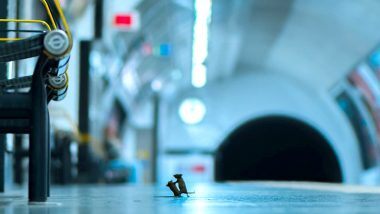
It’s all very distressing if you’re of a nervous disposition, but nowadays the feeling that nature has blood on its hands is long gone. Instead, we are the criminals, the ones red in tooth and claw. In the advanced stages of the Anthropocene, several chapters into a great mass extinction, everything looks like our fault, and objecting to the way big cats exploit the weaknesses of their victims, or malnourished mice resort to fisticuffs, sounds like misplaced sentimentality. I tend to assume that, in one way or another, human beings are the true culprits.
A MISANTHROPIC SCHOOLBOY
If, in this tendency to blame humans, I seem very on trend, it comes from a longstanding prejudice. When I was a boy, I took a huge interest in nature. I read about it and wrote about it in my spare time. I collected the Brooke Bond Tea cards of exotic birds and pretended that the best-looking ones were avian emanations of my favourite girls at school. It was a kind of reverse anthropomorphosis. The illusion brought the girls closer, at least in my fervid imagination. It’s also quite possible that I took what is now a discredited slang term for girls rather too literally, but that was then.
My relationship with nature really took off, however, when my father dug a pond in the back garden. Once it was filled with water and pondweed, I lay on the lawn studying it. Every twitch of pondlife entranced me. During one particular summer’s afternoon, I watched, riveted, as a mosquito hatched on the surface of the water. The whole process took half an hour or more as it dragged its winged body free of the larval husk. Even in the absence of orchestral accompaniment and a soothing voiceover, I was mesmerised.
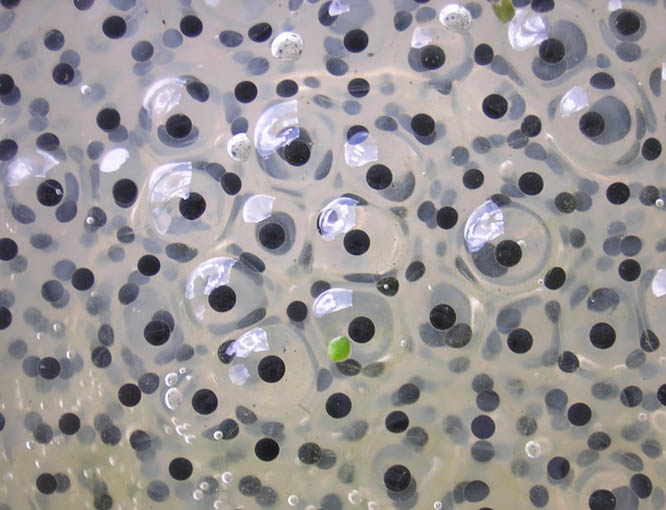
That same year, I kept frog spawn in an aquarium. When they hatched, the tadpoles clung onto their eggs, jet black and motionless, like little punctuation marks. Soon as they began to wriggle about, I fed them on raw liver hooked on a cotton thread dangled in the water and watched as, day by day, their tails shrivelled and their legs grew. I was so successful at rearing them, we soon had a plague of froglets in the neighbourhood. They were sturdy too, for froglets. The local flies had no cause for anxiety. A diet of raw meat had created monsters that turned their noses up at the normal fare. These boy-made froglets could have torn the livers out of the local cats. It’s clear that I had tilted the balance of the local ecosystem in favour of the amphibians, but what would you expect, I’m only human.
As I hit my teens and we moved to the countryside, my interest in birds, once confined to Brooke Bond tea, began to predominate. I learnt how to find their nests in the spring, but never stole the eggs: I was very moral. For the same reason, the persecution of crows by the local farmers outraged me. They would hang dead birds from the gate posts, pour encouragerles autres. Whether this worked I can’t say, though it did seem to depend on the crows having a concept of death and the ability to think ‘If I stay here, it could be me next.’ Corvids are smart, but perhaps not as smart as Ted Hughes would have us believe, and this chain of reasoning seemed like a big ask. I think it was the barbaric gibbeting of these birds that bothered me more than the actual shooting of them. It felt medieval.
The countryside is definitely not for wimps and there would be far worse to come, but those gibbeted crows have lingered in my mind. As I learnt more about human indifference and habitat-destruction, my outrage began to include anyone who menaced the natural order. I still feel this way. The mere thought of ignorant Maltese hunters exterminating the turtle doves as they fly over from Africa is enough to depress me. It’s decades since I last heard turtle doves in an English hedge. We are all the poorer.
When George Osborne, as Chancellor of the Exchequer, spoke of plans for a housing estate in Kent being hindered by ‘feathered obstacles’ it felt even worse. He was talking about nightingales, for pity’s sake. Given the nightingale’s extraordinary song and its unique place in English poetry, his sneer betrayed a kind of wilful philistinism. Now, his political descendants content themselves with building unnecessary and expensive railway lines through ancient woodlands in the nesting season. Morality – of the environmental or any other kind – is not a Tory attribute.
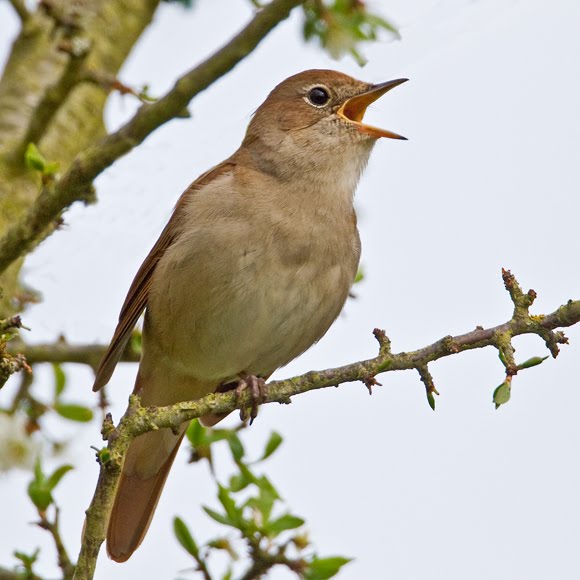
I went on a march recently to protest against the destruction of British wildlife. After a few speeches in the drizzling rain, people set off from Hyde Park and played birdsong on their mobiles along Piccadilly. By the time we had all amassed at the entrance to Downing Street, the sound of birdsong was deafening. There were further speeches, but nothing could touch that alien sound for eloquence. It was as if Whitehall had been rewilded.
Early on, long before George Osborne was tall enough to reach the dispatch box, I had developed such a partisan view that I saw the human species as an evolutionary aberration without which the world would have been a far better place. It remains my default position. It’s not that I see myself as a complete misanthropist, which for the Greeks meant a hater of all mankind. Sir David Attenborough is a man, and I don’t hate him. Mind you, he’s not just anyman, but a naturalist who has put his head above the parapet and told the unfashionable truth that the very success of our species is the main threat to our continued survival.
So no, I don’t hate Sir David. Like any normal person, I adore the man, and despite my long-held preference for the female of the species, there are plenty of men I have a lot of time for. In a certain mood, I can even accept Muddy Waters insisting that, by sheer force of his libido, he can make the moon come up two hours late, or James Brown sobbing ‘This is a man’s world, but it wouldn’t be nothing, nothing, not one little thing, without a woman or a girl…’ Possibly, that was just an excuse for a humble brag about how men made the cars, the trains, the ships, the electric lights and even children’s toys, purely to please her indoors. Oh, and men also made the money to pay for all these goodies. But it wouldn’t mean nothing, etc.
Brown and Waters were writing for another century, of course, around the same time as the moon landings and all that libidinal rocket science. In these shambolic, apocalyptic times, with cities choking on carbon monoxide or (not so long ago) the smoke from bush fires, the oceans filing up with plastic waste and billionaires owning more than entire countries, the world isn’t so unquestionably the divine creation of men. It’s left up to a schoolgirl to save it.
As a schoolboy, back at the time of the moon landings, I was trying my best. The way in which I nurtured those froglets was well-intentioned. Still, it may have seriously upset the delicate balance of my back garden’s biosphere. I wanted to assist Mother Nature by increasing frog numbers. Perhaps it was childish of me to think she needed my help, or that assisting one part of the biosphere would leave the rest of it intact. One messes with these things at one’s peril. If I was so keen to make myself useful, maybe I should have confined my actions to dropping a little Pepsi on the ground before I drank it, the way the indigenous tribes drop a little chicha before they drink, to propitiate Pachamama. Even that would have tilted the balance somewhat, assuming the Pepsi was discovered by ants.
A WORLD WITHOUT US?
Which brings me back to that guilty sensation when I watch nature documentaries. If humans are so destructive, how could one ever atone? Doing nothing, or reducing one’s impact to the minimum, is a deceptive virtue, as omitting to act also has consequences. Those monks of the Jain persuasion mess with the natural order of things every time they swerve to avoid stepping on an ant. If your only goal is to step lightly, rather than trample the dreams of Pachamama, then you can’t win, you will trample her dreams anyway.
Though the urge to minimise one’s impact on the planet may not have much hold over mega-rich partygoers who jet between Ibiza and Mikonos so as not to miss out on any fun, it does appeal to a certain kind of modern ascetic. When Les Knight (‘I campaign for the extinction of the human race,’ Guardian, 10 January 2020) decided the world’s population was unsustainable, for instance, he had a vasectomy to demonstrate that he would not be adding to it.
First blush, that seems like a noble and principled decision to have taken. There are too many people for the planet to sustain. Snip. But, as I say, virtue can be deceptive. What if Mr Knight only succeeded in depriving the world of children who would have shared, and maybe gone on to promulgate, his views? It may not be enough for one man to believe in the extinction of the human race. It may require future generations to make us believe in it.
And then there is one further twist, the fact that the characterisation of Nature as a ‘mother’ is no more based on scientific fact than the belief in Pachamama. Nature is arguably just as annihilating as ‘she’ is nurturing. Marina Hyde seemed to be alluding to this in a typically sardonic reflection on the Australian apocalypse; I mean the one they had last year, about three apocalypses ago for those who are keeping count:
‘Watching the unprecedented fires provokes a strong sense that the Earth is bored with the series, and is fast-forwarding to the end. In fact, there’s a school of thought that says we should stop having the climate emergency discussion in terms of us killing the planet, and reframe it to acknowledge that it will be the planet killing us.’
If this was a feasible view, it would certainly rid us of the present guilt complex. Alright, we shat in our own nest, but even the likes of Andy Coulson deserve a second chance. The earth is not playing fair. Frankly, it needs to look at itself in the mirror.
‘Instead of seeing Mother Nature as a sort of ethereally benign matriarch, it would probably get more people in the right headspace if we thought of her as Medea, or Karen Matthews’ (Guardian, 17 January 2020).
(Medea is shorthand for very poor parenting skills, and for those who are unfamiliar with the name, Karen Matthews was emphatically nota paragon of nurturing motherhood)
This is humour, right?
I doubt Marina Hyde was seriously suggesting we could start viewing the planet as the problem, especially in view of the Guardian’s official policy of calling what’s going on a crisis and an emergency. Perhaps those most deeply in denial about climate change being induced by humans could use a bit of victimhood. The rest of us must live with the guilt.
The idea of the planet killing us because we are killing the planet comes closer to reality. We are caught in a slower version of mutually assured destruction, but the foe is no longer soviet communism. It’s the deceptively cuddly koala bears, representing Mother Nature, while on the opposing side it’s the Australians, her victims, but also a nation over-fond of coal mining. It seemed far way, this antipodean apocalypse, but both parties were caught in a life-and-death struggle that we knew would be coming soon, to an environment near you.
A SHEEP FOR OUR TIMES
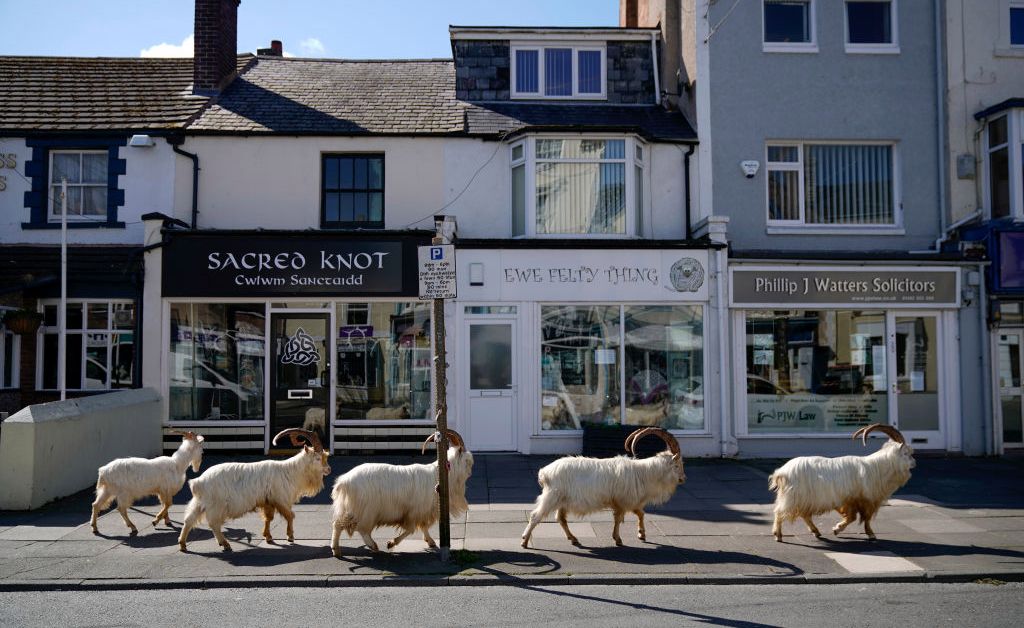
If anyone outside Australia is still in any doubt that this is indeed the apocalypse, they need look no further than Ghent in Belgium. There, in St Bavo’s Cathedral, stands a famous altarpiece. It was painted in oil, back in the early fifteenth century, by Hubert and Jan van Eyck, and has at its centre a scene that comes from the Book of Revelations, known as the Adoration of the Mystic Lamb.
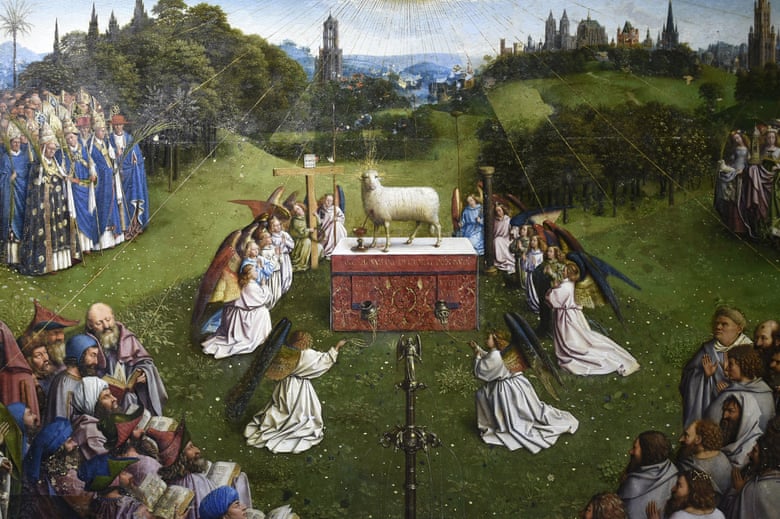

So far, so apocalyptic. But this is no ordinary lamb. You might say it’s a lamb dressed as mutton, as it has long outgrown the gambols of its ovine childhood. It stands with heraldic poise, its left side facing us, on a raised platform surrounded by angels, and from its front a jet of blood arcs through the air before falling into some kind of chalice positioned beneath. This is a reminder of the ‘cannibalistic’ rite that Marcos Zapata would relocate to Cusco. Why the brothers depicted a fully-grown sheep is a mystery, but what is even more enigmatic is the gender of the animal, which is more ewe than ram, since the creature has no horns. Instead, from its head radiate rays of light.
It has been said that the city in the background is Jerusalem, and that the source of light in the picture, being divine, means there are no shadows in the brightly lit scene. I’m not so sure, as there seem to be shadows if you care to notice them, yet the rays of light fanning across the picture from the dove of the Holy Spirit hovering above the skyline advertise the mystical geometry. Our angle on events is not human. It’s as if we are hovering above them like a second dove, or else a drone. The fact that the oil paints were applied onto a chalk background may explain the marvellous luminosity.
All of this had been evident for many years, but when a restoration was attempted and the over-paint on the head of the lamb/sheep was removed – an apocalyptic action in itself, since the word ‘apocalypse’ means to uncover or disclose – the original features freaked out a good few impressionable souls on Twitter. This animal, which is supposed to represent Christ, no longer has eyes at the sides of the head like a normal sheep. They have moved round to where they might be expected to sit in a human face and now stare at every believer and non-believer in the vicinity.

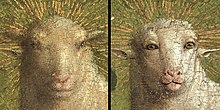
Reactions have varied. Some people just laughed it off, comparing the humanoid sheep to a botched restoration of Ecce Homo in Spain known as Ecce Mono (Behold the monkey).

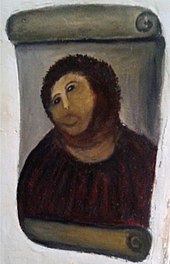
It was an unfair comparison, as the Spanish image was the result of misguided over-painting, rather than of peeling away the later additions.
Others found the gaze of this domesticated animal deeply unsettling. Could this really be a normal example of the beast that gave us the word ‘sheepish’? Its expression is so self-possessed. Those eyes, that gaze, are not sheepish at all; they are knowing. They seem designed to follow you around the nave. Like the grandest of possible inquisitors equipped with a face-recognition camera, they know more about your identity than they should, as if the world has ended and this scarily perceptive sheep is already sorting the nicer ones, the sheep no less, from the errant goats. Takes one to know one. Or as that sage, Jonathan Jones, puts it:
‘…this knowing, anthropomorphic face is not meant to be just any sheep. It is a symbol of Jesus – and he was more man than baa-lamb. Then again, he was neither. Or both. And God besides’ (Guardian, 22 January 2020).
Pity the poor art critics, for they have to wade through this kind of theological quagmire on a regular basis, just to earn a crust. Compared with them, the bishops have it easy, telling people whether they can or cannot have intimate relations with each other according to so few sentences in the Bible you can read them sitting on the throne and still have time to finish Hello! magazine. Perhaps art critics are the only people who still concern themselves with the niceties of theology.
But was Jesus also female? It’s possible that Jones missed the most remarkable thing about this portrayal, though it would not have surprised the Incas from the Cusco school, for whom a feminine deity was the starting point.
If gender assignment is an aspect of the apocalypse, we are in for a lot of confusion, so here are a few of those tell-tale, end-of-days signs to watch out for: if it’s not scrawny guinea pigs, it’ll be transsexual sheep, and if it’s not horses eating each other, it’ll be polar bears jumping onto the backs of beluga whales. Or bat soup.
And if none of the above, it will be pangolins, those same freaky creatures with the dubious distinction of being the world’s most trafficked animal:
‘Though it is true that pangolin scales and meat are advertised as a sort of folk medicine in mainland China, statistics suggest the real key variable are the effects of globalisation, which have enriched the country’s business classes. Price for the animal have climbed from $14 a kilo in 1994 to more than $600 today, while illegal shipments at the border exceed ten tonnes. Customers ordering wildlife often do so in order to flaunt their wealth or to celebrate a good day on the stock market’ (Andrew Liu, Guardian, 10 April 2020)
Maybe our forefathers had it right about omens. There’s usually some kind of freakish behaviour involved, though not necessarily on the part of the beasts. After all, what could be more freakish than a bunch of besuited rentier capitalists watching as a waiter slits a pangolin’s throat, then helping eat these harmless nocturnal mammals to extinction?
Did I say harmless? Perhaps rolling themselves into a ball wasn’t the pangolins’ only method of self-defence. This particular chapter of natural history is still being written.






